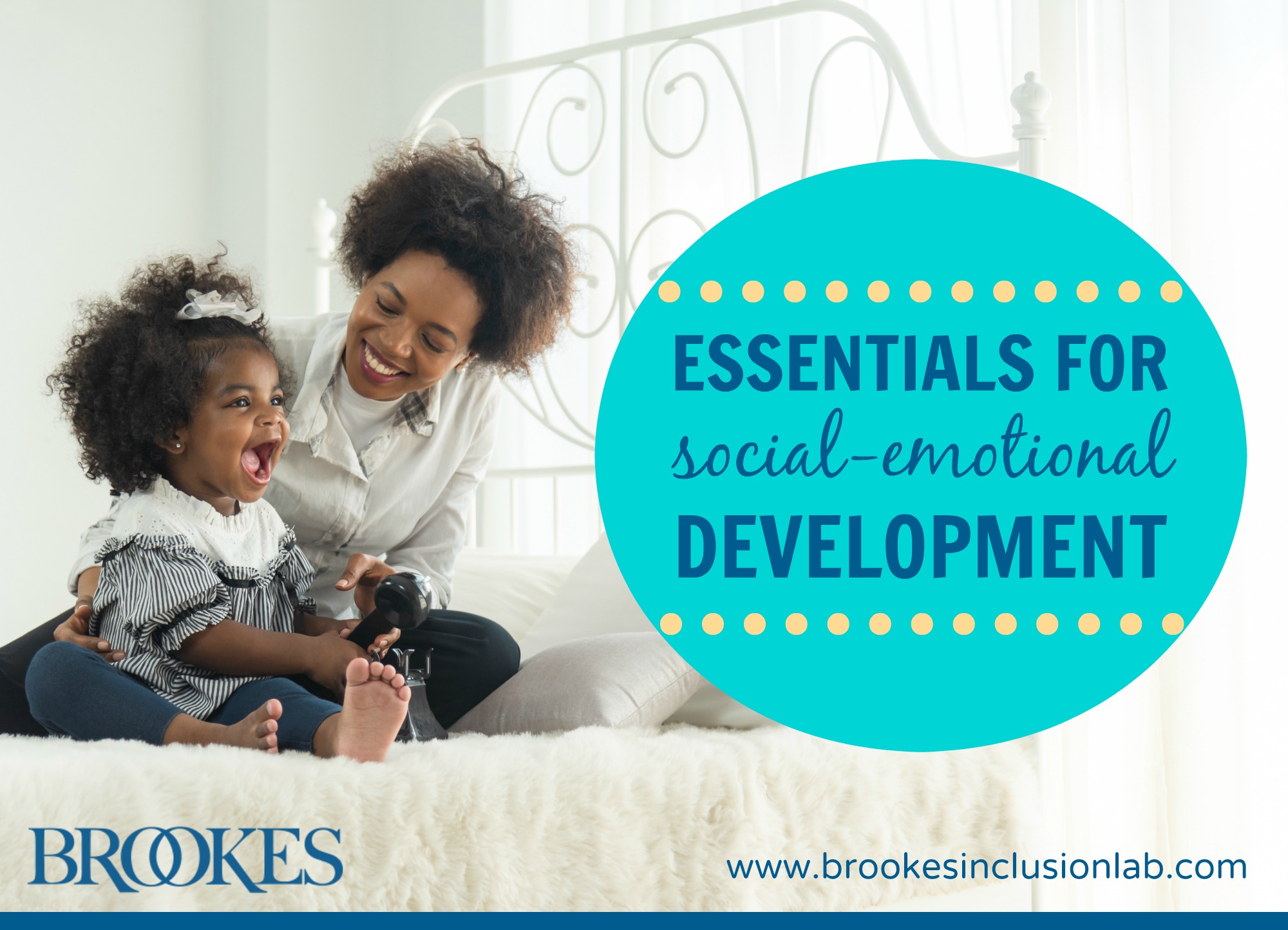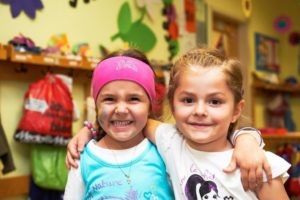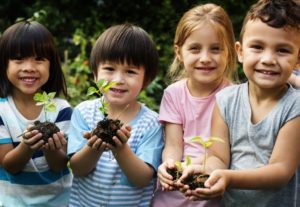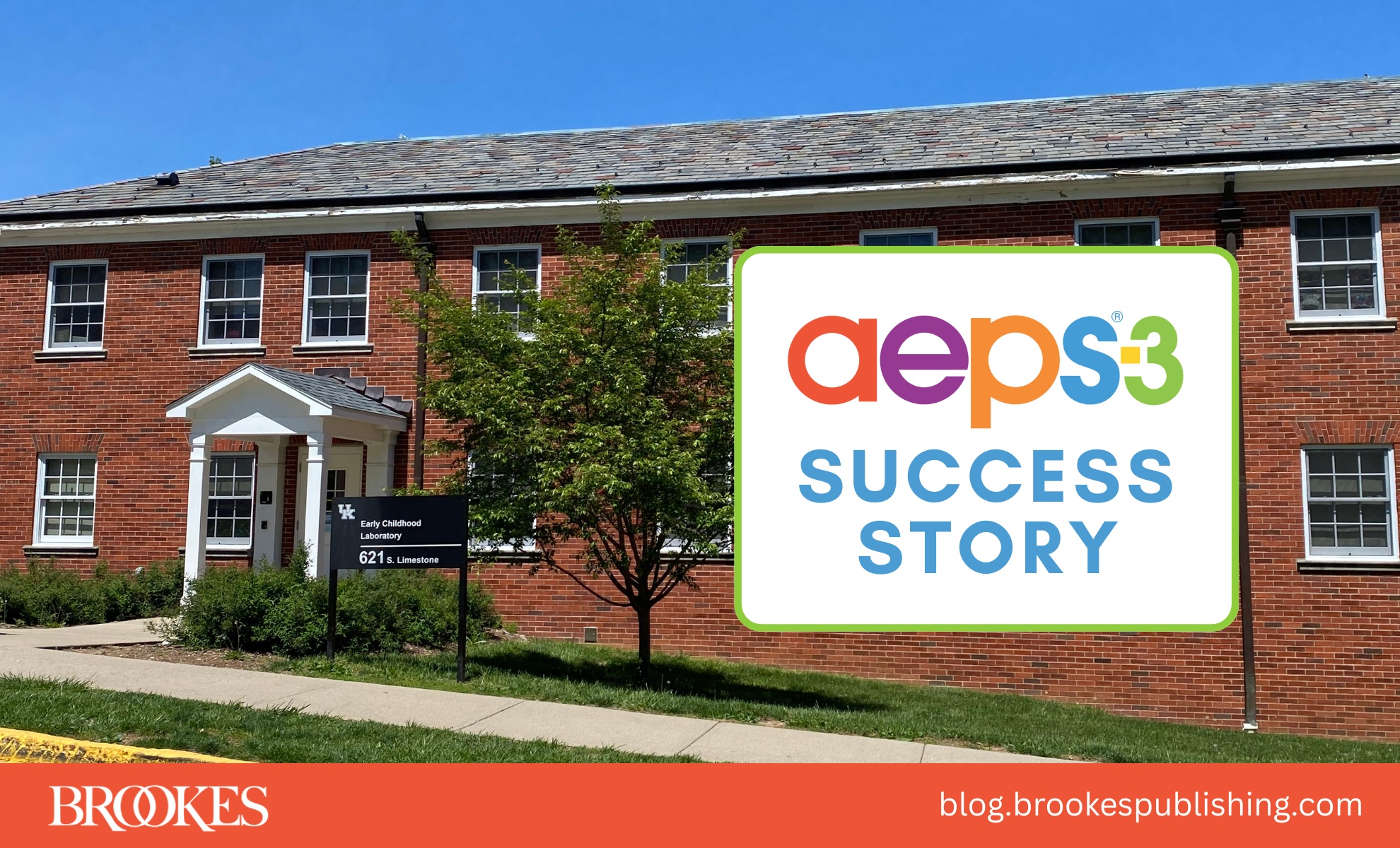10 Essentials for Promoting Young Children’s Social-Emotional Development
February 25, 2020
For children with and without disabilities, strong social-emotional skills are the foundation of long-term success in school, at work, and in the community. With so much at stake, it’s critical to start addressing this key area of development in the early years, even before a child starts school. Educators, child care providers, and parents should all work together to build children’s social-emotional skills, identify potential issues, and mitigate the impact of stressors in a young child’s life.
In today’s post, we bring you 10 important things you can do to support the social-emotional development of young children, from conducting early screening in infancy to helping kids make friends and manage emotions in an early childhood classroom. And we share some helpful links to some of our best expert-developed resources—including books, tools, blog posts, and videos—that provide reliable guidance and support for you and the families you work with.
 Conduct early screening for healthy social-emotional development. Early identification of social-emotional challenges can make a huge difference in the life of a young child. That’s why any effort to nurture social-emotional development should start with regular screening—as early in life as possible. Use a trusted screener like ASQ®:SE-2, a reliable parent-completed tool that lets you screen children as young as 1 month old (and up to 6 years). Administering a screener at regular intervals helps you see where a child’s social-emotional skills are strongest, pinpoint any potential behaviors of concern, and identify any need for further assessment. (See a sample ASQ:SE-2 questionnaire here.)
Conduct early screening for healthy social-emotional development. Early identification of social-emotional challenges can make a huge difference in the life of a young child. That’s why any effort to nurture social-emotional development should start with regular screening—as early in life as possible. Use a trusted screener like ASQ®:SE-2, a reliable parent-completed tool that lets you screen children as young as 1 month old (and up to 6 years). Administering a screener at regular intervals helps you see where a child’s social-emotional skills are strongest, pinpoint any potential behaviors of concern, and identify any need for further assessment. (See a sample ASQ:SE-2 questionnaire here.)
 Follow up with assessment if there are any issues. When results from a screener indicate that a child may need more support in one or more areas, what should you do next? We recommend following up with SEAM™, a discovery and planning tool for helping young children who are at risk for social-emotional challenges. Not only does a SEAM assessment uncover detailed qualitative information on children’s social-emotional competence, it also identifies caregivers’ strengths and areas of need, so you can support better family outcomes as well as child outcomes. SEAM is a great way to start sensitive but important talks with parents, educate families about social-emotional milestones, and start developing functional goals for the child based on their needs. (To learn more about SEAM, download a sample form here, view this prerecorded webinar with two of the developers, and read this article on how to use ASQ:SE-2 and SEAM together.)
Follow up with assessment if there are any issues. When results from a screener indicate that a child may need more support in one or more areas, what should you do next? We recommend following up with SEAM™, a discovery and planning tool for helping young children who are at risk for social-emotional challenges. Not only does a SEAM assessment uncover detailed qualitative information on children’s social-emotional competence, it also identifies caregivers’ strengths and areas of need, so you can support better family outcomes as well as child outcomes. SEAM is a great way to start sensitive but important talks with parents, educate families about social-emotional milestones, and start developing functional goals for the child based on their needs. (To learn more about SEAM, download a sample form here, view this prerecorded webinar with two of the developers, and read this article on how to use ASQ:SE-2 and SEAM together.)
 Give parents learning activities to boost social-emotional development. Between screenings, encourage parents to actively promote their child’s healthy social-emotional development at home. From playing, singing, and talking with a toddler to helping older children process feelings through dramatic play and book reading, there are dozens of simple, low-cost activities parents can try with their children to help them feel safe and loved and learn how to manage emotions. Parents love to have concrete, practical ideas at their fingertips, so share the ASQ®:SE-2 Learning Activities with them—a resource packed with easy age-appropriate activities, newsletters you can send home, and parent handouts on key topics. (You can download six sheets of sample activities here to get you started.)
Give parents learning activities to boost social-emotional development. Between screenings, encourage parents to actively promote their child’s healthy social-emotional development at home. From playing, singing, and talking with a toddler to helping older children process feelings through dramatic play and book reading, there are dozens of simple, low-cost activities parents can try with their children to help them feel safe and loved and learn how to manage emotions. Parents love to have concrete, practical ideas at their fingertips, so share the ASQ®:SE-2 Learning Activities with them—a resource packed with easy age-appropriate activities, newsletters you can send home, and parent handouts on key topics. (You can download six sheets of sample activities here to get you started.)
 Facilitate developmental parenting. Parents are their children’s first teachers—and in the crucial early years, developmentally supportive parenting behaviors contribute significantly to social-emotional learning. In their book Developmental Parenting, Roggman, Boyce, and Innocenti describe the kind of behaviors and attitudes you should encourage parents to cultivate:
Facilitate developmental parenting. Parents are their children’s first teachers—and in the crucial early years, developmentally supportive parenting behaviors contribute significantly to social-emotional learning. In their book Developmental Parenting, Roggman, Boyce, and Innocenti describe the kind of behaviors and attitudes you should encourage parents to cultivate:
Developmental parenting is what parents do to support their children’s learning and development. It is what parents are doing when they clap their hands for their baby’s first steps, soothe their frustrated toddler, encourage their preschool child to sing a song, or ask their first-grade child what happened at school. It is the kind of parenting that values a child’s development, supports a child’s development, and changes along with a child’s development. Developmental parenting is warm, responsive, encouraging, and communicative.
For complete, practical guidance on how to facilitate developmental parenting with families of young children, check out the book. And to see how your efforts are progressing, follow up with PICCOLO™, a quick observational tool that’s designed to assess and monitor the quality of parent–child interactions.
 Help parents approach challenges with positivity. In his book Optimistic Parenting, Dr. V. Mark Durand stresses the importance of developing a confident, positive approach to the challenges parents face every day. Here are a few important messages, adapted from the book, to share with families:
Help parents approach challenges with positivity. In his book Optimistic Parenting, Dr. V. Mark Durand stresses the importance of developing a confident, positive approach to the challenges parents face every day. Here are a few important messages, adapted from the book, to share with families:
- Believe you are a good parent, and know that the positives probably far outweigh any occasional lapses you may experience.
- Believe your child can change their challenging behavior.
- Take care of yourself, because you can’t help your child if you are hurting.
- Parent in the moment—keep reminding yourself to focus on what’s happening right now with your child instead of worrying about other things.
- Recognize and appreciate the good things in life, and practice reminding yourself of the good things that happen each day.
- Remember to express gratitude toward those who help you with your child.
- Recognize that feeling bad sometimes is inevitable for everyone, and accept the fact that there will be “down times.”
Positive, optimistic parenting is contagious, and will likely help a child develop stronger social-emotional skills. To learn more about how to encourage optimism in the families you work with, explore the book and read an author interview here.
 Address stress in your early childhood classroom. Stress isn’t just for grownups. Young children navigate a minefield of stressors that can affect their academic success and social-emotional health, from short-term events like getting scolded by a parent or witnessing a fight at school to long-term situations like divorce, poverty, serious illness, and family relocation. Look for ways to address and reduce stress during the hours that young learners are in your care. Take the time to explain new events to children before they happen, listen empathetically to children’s fears, provide sincere and specific praise, try tension-releasing dances and exercises, and use creative art activities as a way to relieve stress and explore emotions. (For more in-depth ideas, see Alice Honig’s wonderful book Little Kids, Big Worries, read this blog post adapted from the book, and download this free tip sheet of 20 stress-busters.)
Address stress in your early childhood classroom. Stress isn’t just for grownups. Young children navigate a minefield of stressors that can affect their academic success and social-emotional health, from short-term events like getting scolded by a parent or witnessing a fight at school to long-term situations like divorce, poverty, serious illness, and family relocation. Look for ways to address and reduce stress during the hours that young learners are in your care. Take the time to explain new events to children before they happen, listen empathetically to children’s fears, provide sincere and specific praise, try tension-releasing dances and exercises, and use creative art activities as a way to relieve stress and explore emotions. (For more in-depth ideas, see Alice Honig’s wonderful book Little Kids, Big Worries, read this blog post adapted from the book, and download this free tip sheet of 20 stress-busters.)
![]() Embrace the Pyramid Model. Is your program using the Pyramid Model for Promoting Social Emotional Competence in Infants and Young Children? If not, you may want to explore what this approach can do for your program and the children you care for. Widely used across the country by thousands of early childhood professionals, the three-tier Pyramid Model is a framework of practices—universal, targeted, and individualized supports—that help support children’s social-emotional competence and prevent challenging behaviors.
Embrace the Pyramid Model. Is your program using the Pyramid Model for Promoting Social Emotional Competence in Infants and Young Children? If not, you may want to explore what this approach can do for your program and the children you care for. Widely used across the country by thousands of early childhood professionals, the three-tier Pyramid Model is a framework of practices—universal, targeted, and individualized supports—that help support children’s social-emotional competence and prevent challenging behaviors.
Brookes, the publishing company that brings you the Inclusion Lab, has partnered up with the Pyramid Model Consortium (PMC) to expand access to the Pyramid Model and develop and distribute resources and products based on PMC’s work. Over the past few years, we’ve published books, tools, and training modules on the Pyramid Model; you can get an inside look at them here. And to learn more about the Pyramid Model and PMC’s important work, explore the Pyramid Model Consortium’s website.
 Help children understand and manage big emotions. As you’ve probably seen in your classroom or program, young children often grapple with deep and challenging feelings. Worry, anger, fear, envy, and other tough emotions can be a barrier to social and academic success if children aren’t equipped with coping strategies. Teaching kids how to identify and deal with their emotions can be a complex and sensitive undertaking, so it might make sense to try a tested curriculum like Strong Start PreK.
Help children understand and manage big emotions. As you’ve probably seen in your classroom or program, young children often grapple with deep and challenging feelings. Worry, anger, fear, envy, and other tough emotions can be a barrier to social and academic success if children aren’t equipped with coping strategies. Teaching kids how to identify and deal with their emotions can be a complex and sensitive undertaking, so it might make sense to try a tested curriculum like Strong Start PreK.
Developed by a team of educational and mental health experts, this scientifically based curriculum runs for 10 weeks, and lessons are easy to fit into your existing schedule. Through engaging classroom activities, kids will learn how to identify their own feelings, recognize the emotions of others, and deal constructively with anger, worry, and more. Partially scripted lessons, handouts, and worksheets are included, so there’s not too much prep work—you can start using it right away, with no specialized training. (Want to learn more? Download an excerpt here.)
 Promote friendships and other social relationships. Strong, positive connections with peers can help strengthen the social-emotional health of children with and without disabilities. In your classroom or program, every day is packed with great opportunities to promote these connections. Choose collaborative projects and games that motivate children to play together, pair kids with buddies for activities, and explicitly model important social skills like sharing and turn-taking. These Inclusion Lab blog posts give you some practical suggestions on how to help young children develop relationship skills and how to encourage friendships and social play.
Promote friendships and other social relationships. Strong, positive connections with peers can help strengthen the social-emotional health of children with and without disabilities. In your classroom or program, every day is packed with great opportunities to promote these connections. Choose collaborative projects and games that motivate children to play together, pair kids with buddies for activities, and explicitly model important social skills like sharing and turn-taking. These Inclusion Lab blog posts give you some practical suggestions on how to help young children develop relationship skills and how to encourage friendships and social play.
 Create a trauma-sensitive learning environment. Often, the stressors in a child’s life go much deeper than short-term frustrations and fears. Many young children enter programs and classrooms with a history of trauma, which can have a severe impact on social-emotional development if it goes unaddressed. That’s why it’s so important to actively build a trauma-sensitive learning environment for young learners—you’ll help all children feel safe and secure, and you’ll address the needs of children who struggle with the long-term effects of factors such as abuse, neglect, and community violence.
Create a trauma-sensitive learning environment. Often, the stressors in a child’s life go much deeper than short-term frustrations and fears. Many young children enter programs and classrooms with a history of trauma, which can have a severe impact on social-emotional development if it goes unaddressed. That’s why it’s so important to actively build a trauma-sensitive learning environment for young learners—you’ll help all children feel safe and secure, and you’ll address the needs of children who struggle with the long-term effects of factors such as abuse, neglect, and community violence.
To better support young children who experience trauma, start with the work of expert Jen Alexander, a seasoned school counselor, teacher trainer, and author of the book Building Trauma-Sensitive Schools. Read this blog post (adapted from her book) for 11 tips on making your inclusive classroom a safer and more nurturing place for all students, watch a Q&A with Ms. Jen, and get some quick tips and insights from this short video on trauma from Brookes and We Are Teachers.
Consider these 10 essentials as you work with young children and their families, and stay tuned to the Inclusion Lab all year for more tips on promoting healthy social-emotional development in learners of all ages.
 What’s your #1 essential for nurturing social-emotional development in young children? Add your thoughts in the comments below!
What’s your #1 essential for nurturing social-emotional development in young children? Add your thoughts in the comments below!




Write a Comment
Your email address will not be published. Required fields are marked *
comments
Amy says
What a nice post! I am a young parent currently, so I`m really interested in this topic. I have read an interesting article about the emotional development of children (maybe readers of this post would be interested too: https://ivypanda.com/essays/parenting-for-healthy-emotional-development/) and decided to look some more when found your post and blog. Thanks for sharing and keep going!
Marcella Kona Camara-Macauley says
This is very useful.
Francis says
Those 10 essential areas to promote social and emotional are very important.
Post a Comment